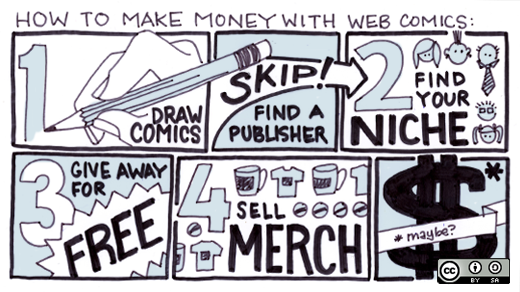While the print comics industry has been slowly shriveling, an interesting new world of comics has emerged on the Internet. Known as webcomics, these new comics range from those professionally illustrated to those, well, not. Whether geek-inspired, or erotica (I'll let you Google that one), webcomics give us an idea of what an industry looks like when its content becomes democratized.
It's not all good, but it's not all bad, either.
Open opportunities
If you were an aspiring comic strip or book creator, there was a time when your publication choices were rather limited. Your best bet, as a strip creator, was to pitch your work to a national syndicate who would take over the marketing and give you a steady (albeit small) paycheck. You were given a fair amount of time to build a national following, and if you didn't, you were done. For those who made comic books, the career path was more variable. You might be a colorist, a writer, or an illustrator; go back far enough and you might have been all three.
Either way, if your ideas weren't well suited to a general audience, you were in trouble.
Over the years, artists did fight back. In the 1960s, small press and self-published Underground Comix began illustrating a netherworld of sex, drugs, and sociopolitical commentary. Some of today's webcomics follow that spirit—and have an easier go at it, as we'll see later. Incensed by shrinking pages for “the funnies,” Bill Watterson battled editors and execs in the 1980s and 90s for more control and print space for Calvin and Hobbes.
But for most creators, the world of print comics was largely regulated by the big syndicates and publishers. In his numerous book compilations, The Far Side creator Gary Larson details many of his rejected comic strips and the (tamed) revisions he sent back to his editor.
Given all the problems with the print industry, it's easy to see the appeal of self-publishing on the Internet.
Show me the money
What's not so easy to see is revenue. Sure, a handful of webcomics make enough money to draw their characters for a living. Likewise, only a small number of print comic strip creators ever made it big. But the income of most webcomic authors comes from merchandising and speaking engagements, not subscriptions or syndication. The financial landscape has changed; the typical webcomic is available for free.
It's the quintessential Internet problem: How do you make a living from your work, when your audience expects you to hand it over free of charge?
Some entrepreneurs have solved it: the Googles and Drupals and iTunes of the world. But print comics' closest cousin, the newspaper, still flounders. Meanwhile the comic book publishers hobble along with a devalued product, and print syndication revenues dwindle for both wire articles and comic strips as small-town newspapers fold.
A promising trend
So maybe the webcomics are onto something. Like the Underground Comix creators of old, they can produce the work they want—even if it isn't suited to a general audience. And unlike Underground Comix, they incur no print or distribution costs, enabling ongoing creation even if they never turn a profit. Their overhead is extremely low, and their revenue streams tend to be risk-free.
They have also built new comics audiences, as their very nature allows webcomics to cater to any niche. There are feminist webcomics, Linux webcomics, even tabletop role-playing webcomics.
Besides a reliable revenue model, the only things missing are some bug-eyed anthropomorphic chickens and that little spike-haired boy with a stuffed tiger.






2 Comments